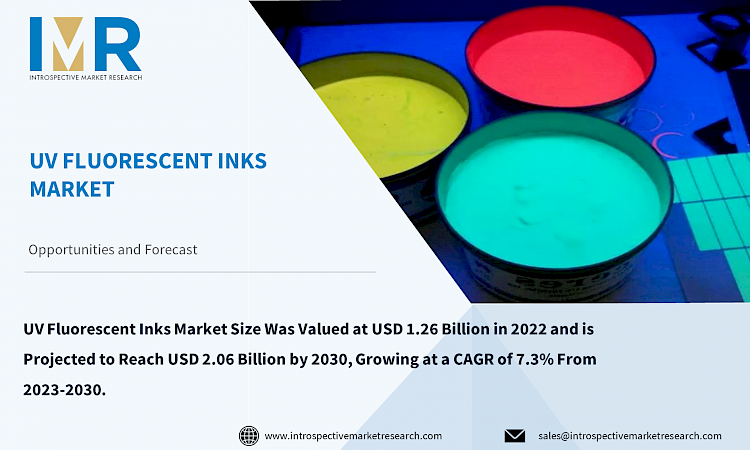Market Overview:
UV Fluorescent Inks Market Size Was Valued at USD 1.26 Billion in 2022 and is Projected to Reach USD 2.06 Billion by 2030, Growing at a CAGR of 7.3% From 2023-2030.
UV fluorescent inks are special inks that become visible under ultraviolet (UV) light. These inks contain fluorescent compounds that emit visible light when exposed to UV radiation, creating vibrant and eye-catching effects. They find applications in various industries, such as printing, packaging, security, and advertising. In the printing industry, UV fluorescent inks are used for creating attention-grabbing designs on posters, labels, and packaging materials. In security printing, they are employed for anti-counterfeiting measures, as the fluorescence is often challenging to replicate. Current trends in the market indicate a growing demand for UV fluorescent inks due to their versatility and ability to enhance visual appeal. The increased focus on brand differentiation and product authenticity, along with advancements in printing technology, is driving the adoption of UV fluorescent inks across different sectors. Additionally, the environmental benefits of UV inks, which typically contain fewer volatile organic compounds (VOCs), contribute to their rising popularity in the market.
Top Key Players Covered In The UV Fluorescent Inks Market:
- HP Development Company L.P. (US)
- SwissQprint AG (Switzerland)
- NUtec Digital Ink (Pty) Ltd (South Africa)
- Domino Printing Sciences plc (US)
- Maxell Ltd (Japan)
- Petrel Ltd (UK)
- EPTANOVA S.R.L. (US), and Other Major Players
Market Dynamics and Factors:
Market drivers for UV fluorescent inks include the growing demand for visually appealing and unique packaging solutions across industries, particularly in the consumer goods and retail sectors. These inks provide a distinctive advantage in product differentiation and brand recognition, driving their adoption in label printing, packaging, and advertising. The increasing emphasis on anti-counterfeiting measures also propels the demand for UV fluorescent inks in security applications, bolstering their use in banknotes, identification cards, and other sensitive documents. Furthermore, the ongoing advancements in printing technology, including digital printing methods, contribute to the expansion of the UV fluorescent inks market, offering more efficient and customizable printing solutions.
However, certain restraints exist in the market, such as the initial high costs associated with UV curing equipment and the inks themselves. This can pose a barrier to entry for small and medium-sized enterprises. Additionally, concerns about the environmental impact of UV inks, particularly in terms of energy consumption during the curing process and disposal of UV-related waste, may limit their adoption.
Opportunities in the UV fluorescent inks market lie in the development of eco-friendly formulations, addressing environmental concerns, and aligning with the increasing focus on sustainable practices. The continuous innovation in UV ink technology to reduce costs and enhance performance, coupled with the expansion of end-use applications, opens avenues for growth in this dynamic market.
The UV Fluorescent Inks Market Report Highlight:
- By Type, In the UV fluorescent inks market, the oil-based type is anticipated to be the dominant variant, capturing a substantial market share. This dominance is attributed to the favorable properties of oil-based formulations, including enhanced durability, vivid color reproduction, and versatility across various substrates, making them preferred in applications such as packaging, labeling, and security printing.
- By Application, In the UV fluorescent inks market, securities, including banknotes and identification documents, are anticipated to emerge as the most dominant application. The demand for these inks in security printing is driven by the need for robust anti-counterfeiting measures, as the distinctive fluorescence adds a layer of authenticity, making it a key application within the market.
- By Region, In the UV fluorescent inks market, North America is anticipated to emerge as the most dominant region. This dominance is attributed to the region's robust printing and packaging industry, coupled with a high demand for visually appealing and secure printing solutions. Additionally, technological advancements and a focus on product authenticity contribute to the market's strong presence in North America.
Key Industry Development:
- In October 2023, SICPA, in partnership with IATA and industry collaborators, showcased the inaugural digital identity proof of concept for travel. The demonstration, presented at the IATA World Passenger Symposium, illustrated a seamless journey from flight booking to border crossing, marking a milestone in secure identity data processing from London Heathrow to Rome Fiumicino with British Airways on October 25, 2023.
- In June 2023, INX International Ink Co. invested in Debut, a synthetic biology company specializing in innovative active ingredients for natural colors. Debut employs a proprietary biomanufacturing platform using "cell-free" and advanced methods like continuous biomanufacturing to enhance efficiency and sustainability, reducing space, water, and costly inputs. Overcoming traditional limitations, Debut's technology accelerates the production of high-value ingredients, offering a more rapid and sustainable approach compared to cell-based fermentation in the manufacturing of rare and novel compounds.
The UV Fluorescent Inks Market Segmentation:
By Type
- Oil-Based
- Solvent-Based
- Water-Based
- UV-Cured
- Neon-Based
By Product Type
- Invisible Fluorescent UV Ink
- Visible Fluorescent UV Ink
By Application
- Securities
- Certificates
- Passports
- Cosmetics
For this report, Introspective Market Research has segmented the UV Fluorescent Inks Market based on region:
Regional Outlook (Revenue in USD Million; Volume in Units, 2023-2030)
North America
- The U.S.
- Canada
- Mexico
Eastern Europe
- Russia
- Bulgaria
- The Czech Republic
- Hungary
- Poland
- Romania
- Rest of Eastern Europe
Western Europe
- Germany
- UK
- France
- Netherlands
- Italy
- Spain
- Rest of Western Europe
Asia Pacific
- China
- India
- Japan
- Singapore
- Australia
- New-Zealand
- Rest of APAC
Middle East & Africa
- Turkey
- Saudi Arabia
- Qatar
- UAE
- Israel
- South Africa
South America
- Brazil
- Argentina
- Rest of SA





